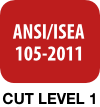The Portwest A352 DermiFlex Ultra Glove is ¾ coated for added protection to the back of the hand. This glove also has a seamless breathable knitted liner for comfort and dexterity.


EN 420, EN 388

Product Technical Information
Standards
Documentation
Protective Gloves : General Requirements
EN420 : 2003 + A1 2009
This standard defines the general requirements for glove design and construction, innocuousness, cleaning instructions, electrostatic properties, sizing, dexterity, water vapour transmission and absorption along with marking and information
EN 388
Gloves giving protection from mechanical risks
Protection against mechanical hazards is expressed by a pictogram followed by four numbers (performance levels), each representing test performance against a specific hazard.
1 Resistance to abrasion
Based on the number of cycles required to abrade through the sample glove (abrasion by sandpaper under a stipulated pressure). The protection factor is then indicated on a scale from 1 to 4 depending on how many revolutions are required to make a hole in the material. The higher the number, the better the glove. See table below.
2 Blade cut resistance
Based on the number of cycles required to cut through the sample at a constant speed. The protection factor is then indicated on a scale from 1 to 4.
3 Tear resistance
Based on the amount of force required to tear the sample.
The protection factor is then indicated on a scale from 1 to 4.
4 Puncture resistance
Based on the amount of force required to pierce the sample with a standard sized point. The protection factor is then indicated on a scale from 1 to 4.
